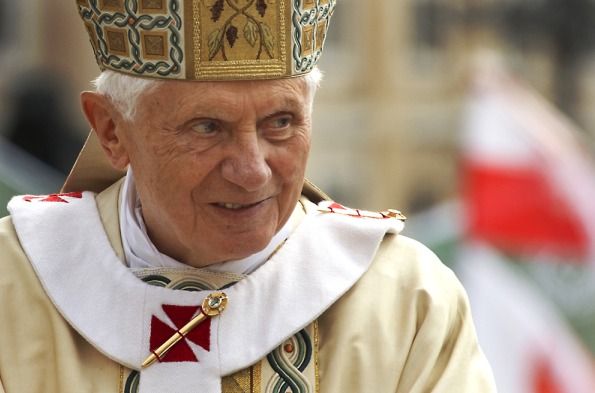Papal Election Triggers Doomsday Theories

The beginning of papal conclave to elect a new head of the Catholic Church has some people worrying the end is nigh.
These believers interpret two medieval-era prophecies to mean that the next pope elected will be the last before doomsday. One prophecy allegedly comes from a 12th-century archbishop, the other from no less famed a name than Nostradamus himself. Both could be charitably described as "open to interpretation."
The first set of prophecies, known as the Saint Malachy prophecies, are allegedly written by the saint himself, an archbishop in the 1100s. However, these prophecies weren't published until 1595, when a Benedictine monk claimed to have found them; the Catholic Church does not consider them to be from Saint Malachy's pen.
Listing the popes
The Saint Malachy prophecies consist of 112 short phrases, each of which has been interpreted to represent a particular pope, in order. The phrases are quite accurate up to about 1590, but get rather vague after that point, lending credence to the suggestion that they are a 16th-century forgery. For example, Pope Adrian IV, who headed the Catholic Church from 1154-1159, is described as "from the white countryside, humbly born in the town of St. Albans," which accurately represents the pope's birthplace in England.
Compare that specificity to the post-1590 popes: Leo XI, who was briefly pope in 1605, matches the entry on the list that simply says "wavy man." Benedict XIV (1740-1758) gets the descriptor "country animal." Paul VI (1963-1978) is simply "flower of flowers."
That hasn't stopped believers from interpreting the vague phrases to match some event or perceived trait of each pope. Under these interpretations, Pope John Paul II, who died in 2005, was pope No. 110, "from the labor of the sun," so defined, believers say, because there were solar eclipses somewhere in the world when John Paul II was born and on the day of his funeral. [History's 10 Most Intriguing Popes]
Sign up for the Live Science daily newsletter now
Get the world’s most fascinating discoveries delivered straight to your inbox.
That makes recently retired Benedict XVI, No. 111, the "glory of the olive." Proponents say this descriptor fits because Benedict chose his papal name after the saint who founded the Benedictine Order, which has a branch called the Olivetans (of which Benedict was not one).
Benedict XVI's status as No. 111 matters because pope No. 112 is the last on the list. "In the final persecution of the Holy Roman Church, there will sit Peter the Roman, who will pasture his sheep in many tribulations, and when these things are finished, the city of seven hills will be destroyed, and the dreadful judge will judge his people," the line reads. "The End."
Nostradamus gets involved
These supposed tribulations won't take long, say some believers. According to the crowd-sourced news website Before It's News, the 16th-century apothecary and supposed prophet Nostradamus predicted that the last pope would flee Rome in December when "two suns" seem to appear in the sky. The prophecy is making the rounds online paired with the suggestion that the second "sun" will be Comet ISON, which will come closest to the sun on Nov. 28, 2013.
If the comet survives its brush with the sun, it could swing back by Earth, potentially shining bright enough to be visible in daylight.
But Nostradamus' prophecy is, like all of his four-line quatrains, undated, and does not refer specifically to the final pope. The original (translated from French) reads:
"The great star for seven days shall burn
So nakedly clear like two suns appearing
The large dog all night howling
While the great Pontiff shall change his territory."
Unsurprisingly, old doomsday hands have been interpreting this one for ages, with at least one online source suggesting that it was meant to predict Pope John Paul II fleeing Italy during a Muslim invasion. Another expects World War III.
Doomsday's draw
The never-ending interpretations suggest the next pope's reign may be fraught with conspiracy theories. Even if this pope and the one after rule without apocalyptic incident, it's unlikely that doomsday theorists will go away. [The 10 Greatest Conspiracy Theories Explained]
Both Nostradamus and the author of the Saint Malachy propechies used vague enough wording that the phrases can be twisted to mean almost anything. And end-of-the-world predictions are woven into the fabric of human history, reaching back thousands of years. In the 1500s, astrologers predicted that the planets would align, ending the world. In 1844, Baptist preacher William Miller predicted an Oct. 22 doomsday. In 2011, preacher Harold Camping predicted the Rapture on May 21, followed by Judgment Day on Oct. 21. And in 2012, believers bought into the hype of the Mayan apocalypse.
If the pope prophecies don't pan out, there are plenty of predictions waiting in the wings, including numerological prognostications set for 2040 and 2080 and speculations from Sir Isaac Newton, whose calculations from the Bible led him to muse that the world might end in 2060.
Follow Stephanie Pappas @sipappas. Follow Live Science on Twitter @livescience, Facebook or Google+. Original article on Live Science.

Stephanie Pappas is a contributing writer for Live Science, covering topics ranging from geoscience to archaeology to the human brain and behavior. She was previously a senior writer for Live Science but is now a freelancer based in Denver, Colorado, and regularly contributes to Scientific American and The Monitor, the monthly magazine of the American Psychological Association. Stephanie received a bachelor's degree in psychology from the University of South Carolina and a graduate certificate in science communication from the University of California, Santa Cruz.

Ancient Egyptian pyramids, thought to contain only the elite, may also hold low-class laborers

'Potentially hazardous' pyramid-size asteroid will make its closest flyby of Earth for more than 100 years this Wednesday

China's new 2D transistor could soon be used to make the world's fastest processors






